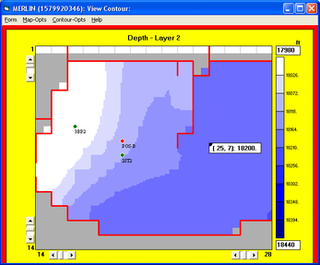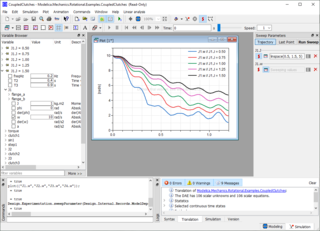
Maple is a symbolic and numeric computing environment as well as a multi-paradigm programming language. It covers several areas of technical computing, such as symbolic mathematics, numerical analysis, data processing, visualization, and others. A toolbox, MapleSim, adds functionality for multidomain physical modeling and code generation.

Simulink is a MATLAB-based graphical programming environment for modeling, simulating and analyzing multidomain dynamical systems. Its primary interface is a graphical block diagramming tool and a customizable set of block libraries. It offers tight integration with the rest of the MATLAB environment and can either drive MATLAB or be scripted from it. Simulink is widely used in automatic control and digital signal processing for multidomain simulation and model-based design.

Waterloo Maple Inc. is a Canadian software company, headquartered in Waterloo, Ontario. It operates under the trade name Maplesoft. It is best known as the manufacturer of the Maple computer algebra system, and MapleSim physical modeling and simulation software.

Modelica is an object-oriented, declarative, multi-domain modeling language for component-oriented modeling of complex systems, e.g., systems containing mechanical, electrical, electronic, hydraulic, thermal, control, electric power or process-oriented subcomponents. The free Modelica language is developed by the non-profit Modelica Association. The Modelica Association also develops the free Modelica Standard Library that contains about 1400 generic model components and 1200 functions in various domains, as of version 4.0.0.

Hopsan is a free simulation environment for fluid and mechatronic systems, developed at Linköping University. Although originally developed for simulation of fluid power systems, it has also been adopted for other domains such as electric power, flight dynamics, and vehicle dynamics. It uses bi-directional delay lines to connect different components.

Reservoir simulation is an area of reservoir engineering in which computer models are used to predict the flow of fluids through porous media.
Dynamic simulation is the use of a computer program to model the time-varying behavior of a dynamical system. The systems are typically described by ordinary differential equations or partial differential equations. A simulation run solves the state-equation system to find the behavior of the state variables over a specified period of time. The equation is solved through numerical integration methods to produce the transient behavior of the state variables. Simulation of dynamic systems predicts the values of model-system state variables, as they are determined by the past state values. This relationship is found by creating a model of the system.
Automation Studio is a circuit design, simulation and project documentation software for fluid power systems and electrical projects conceived by Famic Technologies Inc.. It is used for CAD, maintenance, and training purposes. Mainly used by engineers, trainers, and service and maintenance personnel. Automation Studio can be applied in the design, training and troubleshooting of hydraulics, pneumatics, HMI, and electrical control systems.

Dymola is a commercial modeling and simulation environment based on the open Modelica modeling language.
CAMeL-View is a software application, which is used for the model based design of mechatronic systems.

SimulationX is a CAE software application running on Microsoft Windows for the physical simulation of technical systems. It is developed and sold by ESI Group.
The Functional Mock-up Interface defines a standardized interface to be used in computer simulations to develop complex cyber-physical systems.

20-sim is commercial modeling and simulation program for multi-domain dynamic systems, which is developed by Controllab. With 20-sim, models can be entered as equations, block diagrams, bond graphs and physical components. 20-sim is widely used for modeling complex multi-domain systems and for the development of control systems.
JModelica.org is a commercial software platform based on the Modelica modeling language for modeling, simulating, optimizing and analyzing complex dynamic systems. The platform is maintained and developed by Modelon AB in collaboration with academic and industrial institutions, notably Lund University and the Lund Center for Control of Complex Systems (LCCC). The platform has been used in industrial projects with applications in robotics, vehicle systems, energy systems, CO2 separation and polyethylene production.
Wolfram System Modeler, developed by Wolfram MathCore, is a platform for engineering as well as life-science modeling and simulation based on the Modelica language. It provides an interactive graphical modeling and simulation environment and a customizable set of component libraries.
Simcenter Amesim is a commercial simulation software for the modeling and analysis of multi-domain systems. It is part of systems engineering domain and falls into the mechatronic engineering field.

Simantics System Dynamics is a ready-to-use system dynamics modelling and simulation software application for understanding different organizations, markets and other complex systems and their dynamic behavior.
System-level simulation (SLS) is a collection of practical methods used in the field of systems engineering, in order to simulate, with a computer, the global behavior of large cyber-physical systems.
Predictive engineering analytics (PEA) is a development approach for the manufacturing industry that helps with the design of complex products. It concerns the introduction of new software tools, the integration between those, and a refinement of simulation and testing processes to improve collaboration between analysis teams that handle different applications. This is combined with intelligent reporting and data analytics. The objective is to let simulation drive the design, to predict product behavior rather than to react on issues which may arise, and to install a process that lets design continue after product delivery.










